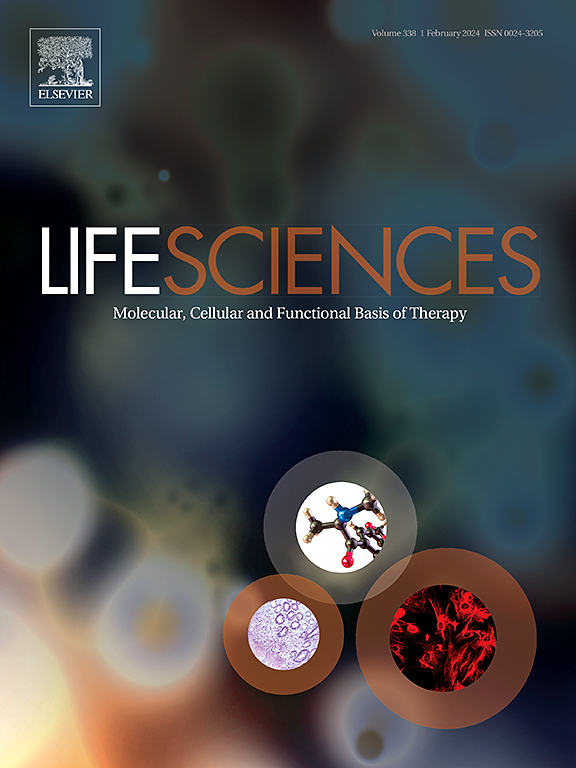BDNF/TrkB signaling pathway and WDR neurons: Core factors inducing central sensitization of neuropathic pain
IF 5.1
2区 医学
Q1 MEDICINE, RESEARCH & EXPERIMENTAL
引用次数: 0
Abstract
Neuropathic pain is a complex pain syndrome resulting from damage or dis-ease affecting the somatosensory nervous system. Currently, there are no effective treatment options available, which has drawn considerable attention from researchers due to its high prevalence. The mechanisms underlying neuropathic pain are multifaceted, involving structural and functional alterations in central nervous system (CNS), pain signals transduction, and neuroinflammation, with central sensitization recognized as an important mechanism. Central sensitization is characterized by increased neuronal excitability and synaptic plasticity. Brain-derived neurotrophic factor (BDNF) plays a pivotal role in central sensitization induced by nerve injury through its binding to the tropomyosin receptor kinase B (TrkB) receptor. The activation of BDNF/TrkB signaling pathway modulates neuronal synaptic plasticity and enhances the transmission of pain signals. Additionally, the spinal dorsal horn (SDH) wide dynamic range (WDR) neurons act as integrative centers for pain signals, receiving inputs from peripheral nociceptive stimuli and exhibiting heightened excitability in neuropathic pain. Hyperexcited WDR neurons not only respond to central sensitization but also are further intensified by BDNF/TrkB signaling pathway, ultimately amplifying pain perception. This review intends to systematically summarize the interactions between central sensitization, BDNF/TrkB signaling, and WDR neurons, illustrating their potential relationships in neuropathic pain and identifying possible intervention targets, thereby offering new insights and strategies for neuropathic pain relief.

BDNF/TrkB信号通路和WDR神经元:诱发神经性疼痛中枢致敏的核心因子
神经性疼痛是一种复杂的疼痛综合征,由影响体感觉神经系统的损伤或疾病引起。目前,尚无有效的治疗方案,由于发病率高,引起了研究人员的极大关注。神经性疼痛的机制是多方面的,涉及中枢神经系统(CNS)的结构和功能改变、疼痛信号传导和神经炎症,其中中枢致敏被认为是一个重要的机制。中枢敏化的特点是神经元兴奋性和突触可塑性增加。脑源性神经营养因子(BDNF)通过与原肌球蛋白受体激酶B (TrkB)受体结合,在神经损伤诱导的中枢致敏中起关键作用。BDNF/TrkB信号通路的激活调节神经元突触的可塑性,增强疼痛信号的传递。此外,脊髓背角(SDH)宽动态范围(WDR)神经元作为疼痛信号的整合中心,接受来自外周伤害性刺激的输入,并在神经性疼痛中表现出高度的兴奋性。高兴奋的WDR神经元不仅响应中枢致敏,还被BDNF/TrkB信号通路进一步强化,最终放大痛觉。本综述旨在系统总结中枢致敏、BDNF/TrkB信号和WDR神经元之间的相互作用,阐明它们在神经性疼痛中的潜在关系,并确定可能的干预靶点,从而为神经性疼痛的缓解提供新的见解和策略。
本文章由计算机程序翻译,如有差异,请以英文原文为准。
求助全文
约1分钟内获得全文
求助全文
来源期刊

Life sciences
医学-药学
CiteScore
12.20
自引率
1.60%
发文量
841
审稿时长
6 months
期刊介绍:
Life Sciences is an international journal publishing articles that emphasize the molecular, cellular, and functional basis of therapy. The journal emphasizes the understanding of mechanism that is relevant to all aspects of human disease and translation to patients. All articles are rigorously reviewed.
The Journal favors publication of full-length papers where modern scientific technologies are used to explain molecular, cellular and physiological mechanisms. Articles that merely report observations are rarely accepted. Recommendations from the Declaration of Helsinki or NIH guidelines for care and use of laboratory animals must be adhered to. Articles should be written at a level accessible to readers who are non-specialists in the topic of the article themselves, but who are interested in the research. The Journal welcomes reviews on topics of wide interest to investigators in the life sciences. We particularly encourage submission of brief, focused reviews containing high-quality artwork and require the use of mechanistic summary diagrams.
 求助内容:
求助内容: 应助结果提醒方式:
应助结果提醒方式:


